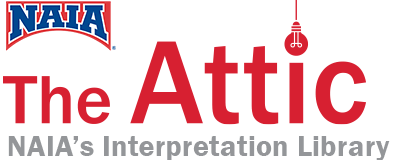-
Outside Competitive Experience Update – As of 2021-2022
Elite-Level Criteria & Chargeable Outside Competitive Experience Effective May 1, 2022 as applied to eligibility decisions for NAIA competition in August 2022 or beyond. Applied to eligibility decisions for NAIA competition in August 2022 and beyond. This means that this criteria is not retroactive. If a student was charged for a league prior to May…
-
Progress Rule GPA & Exception
Bylaw Article V, Section C, Item 9b and exception Amended at the 2021 National Convention – Applicible for all eligibility decisions May 1, 2022 and thereafter. “To participate in a second, third and/or fourth season in a sport, all students must have and maintain a total cumulative GPA of at least 2.000 on a 4.000…
-
Additional Scrimmage Dates
Bylaw: Article I, Section H, Item 2 “The following number of scrimmage dates per sport will be allowed in addition to the maximum number of varsity games, contests, or playing dates which an institution may schedule or in/on which a student may compete.” Additional Scrimmage Dates Effective Fall 2023: Sport Number of Scrimmage Dates Baseball…
-
Calculating Forfeits & Rescheduled Games into FOP Limits
Bylaw: Article I, Section H, Item 1 “The maximum number of varsity games, contests or playing dates an institution may schedule is listed in Article I, Section H, Item 1… Further, no student may compete in a sport in an academic year in more than the number of games, contests or playing dates listed below…
-
Extended Games & Frequency of Play Limits
Bylaw: Article I, Section H, Item 1 “The maximum number of varsity games, contests or playing dates an institution may schedule is listed in Article I, Section H, Item 1… Further, no student may compete in a sport in an academic year in more than the number of games, contests or playing dates listed below…
-
Concurrent Enrollment
Bylaw: Article V, Section B, Item 21 “Term of Attendance: A term of attendance is any quarter, semester or trimester (excluding summer sessions) in which the student becomes identified at a single institution. The word “term” as used throughout the bylaws refers to quarter, semester or trimester, whichever applies as the official unit of class…
-
Credits Used for 12-Hour Enrollment Rule
Bylaw: Article V, Section C, Item 3 “The student must be identified and enrolled in a minimum of 12 institutional credit hours at the time of participation.” Interpretation A student may use test credit or credit earned through course placement in order to meet the 12-Hour Enrollment Rule. Credit must be shown as completed…
-
24/36-Hour Rule Exception 3: Competition After Two Quarter Terms of Attendance
Bylaw: Article V, Section C, Item 6 “A student in a quarter system must have accumulated 24 institutional credit hours in the previous two quarter terms of attendance if completion of three quarter terms of attendance has not occurred. Upon completion of three quarter terms of attendance the student must have accumulated 36 institutional credit…
-
Progress Rule Exception Mixed Terms
Bylaw: Article V, Section C, Item 9 “To participate a second season in a sport, all students must have accumulated at least 24 semester/36 quarter (or equivalent) institutional credit hours. EXCEPTION: A freshman who initially becomes identified after the first term in the fall shall meet this requirement by having passed 12 semester or 20…
-
Retaining Eligibility for NAIA Postseason
Bylaw: Article V, Section D, Item 4 “A student who is eligible during the regular sport season for a particular sport and who is eligible at the end of the regular sport season shall retain eligibility in that particular sport for participation in NAIA postseason competition provided the student was in attendance the term immediately…
